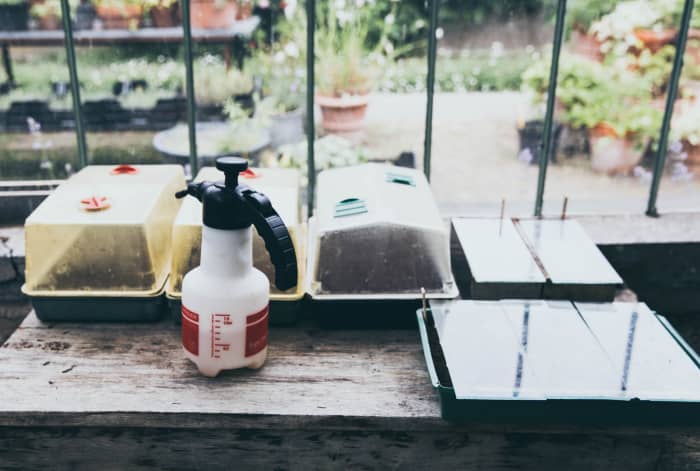How to Get Rid of Aphids on Plants
Lynn has been a professional organic farmer for the last 35 years and runs a 210-acre farm in Western Colorado with her husband.

If your garden is being plagued by pests, these natural solutions will help.
Photo by Markus Winkler on Unsplash
Are there plants disappearing from your garden? Are there holes in the leaves? Are your plants sticky? You may have a pest problem in your garden. Eliminating those pests is key to you getting a good crop.
There's No Such Thing as a "Perfect" Garden
I've heard people claim that if you grow your garden perfectly, no bug will attack your plants. That's a really tall order. Something totally out of your control, like a weather event, can throw your garden off. I don't think I can even grow a garden perfectly, and I've been a professional organic farmer for over 35 years.

From DIY sprays to ones you can pick up at your local hardware store, there are several easy and natural ways to rid your garden of aphids.
Photo by Stella de Smit on Unsplash
There are several notorious pests that come around every year and do their best to destroy gardens, but luckily there are also a few ways to get aphids (and other pests) out of your garden safely and naturally.
1. Pyrethrin Spray or Powder
Pyrethrins are naturally occurring pesticides from the chrysanthemum family. You can spray them on plants or use them as a powder. You can buy pyrethrins at most hardware or home improvement stores.
2. Safer® Soap
This works well on aphids as long as you get it on their bodies. Aphids breathe through their pores, and the Safer® soap clogs their pores so they can't breathe anymore. In other words, it kills by suffocation. Like pyrethrins, this product is also available at most hardware and home improvement stores.
3. DIY Repellant Spray
This repellent spray is made with simple items you probably already have in your kitchen. It can be used to repel aphids, whiteflies, slugs, and cutworms. You'll want to apply this spray about once a week (and reapply after it rains). To make spray:
- Mince one bulb of garlic.
- Dice one small onion.
- Mix garlic and onion with 1 tablespoon of cayenne pepper in a quart of water.
- Let mixture steep for about three hours.
- Add a tablespoon of liquid soap.
- Strain mixture.
- Put it in your sprayer and spray it on affected plants.
4. DIY Garlic Oil Spray
This spray is great for control over aphids, cabbage loopers, earwigs, June bugs, leafhoppers, squash bugs, and whiteflies. You probably need to use it at least once a week (reapplying after rain). To make spray:
- Mince one bulb of garlic.
- Soak minced garlic in 2 teaspoons of mineral oil.
- Let mixture steep for about 24 hours.
- Mix 1 pint of water with 1 tablespoon of liquid soap.
- Add the garlic mixture to the soapy water and mix thoroughly.
- Strain out the garlic, and place the oil into a jar for storage.
- Dilute 1 to 2 tablespoons of garlic oil in 2 cups of water.
- Spray mixture over the leaf surface of your plant.
Read More From Dengarden
How to Tell What's Eating Your Plants
If you can't figure out what is eating your plants, here's a quick and easy way to find out. Go out into your garden at night with a flashlight and take a look around.
The garden's a whole other world at night! A lot of pests come out at night to eat, and you want to be out there looking at what's actually doing all the chewing. You may also be able to figure out what's eating your plants by looking for signs on their leaves. Here are some tips on how to identify common leaf-eating pests by looking at what they do to your plants.

Though aphids come in a variety of colors, most common garden aphids are green.
Photo by Viktor Forgacs on Unsplash
Aphids are soft-bodied, pear-shaped insects that suck the juice out of your plants. Some aphids have wings. Most aphids are green (though they also come in red, yellow, gray, and black) and are about 1/8-inch long, with six legs.
Aphids are typically active in the spring and make their appearance as soon as it gets warm.
Aphid Reproduction
A not-so-fun fact? They're born pregnant. Yep, they're born pregnant. Female aphids can give live birth to pregnant females, which can occur for several generations.
In the fall, female aphids mate with the males to produce eggs that winter over.

Ants and aphids often have a symbiotic relationship—which means if you have one, you probably have the other!
Image by Jerzy Górecki from Pixabay
Got Ants? Then You Probably Have Aphids Too.
Aphids also secrete a sticky honeydew substance from their rear ends...which ants love. Nearby ants will carry the aphids around and harvest the honeydew from them. In the fall, the ants will carry the aphid eggs into their nest and take care of them until spring. And then in the spring, the ants will return the aphid eggs to the plants.
So if you have an ant invasion, you'll want to go ahead and look for aphids.
This content is accurate and true to the best of the author's knowledge and is not meant to substitute for formal and individualized advice from a qualified professional.
© 2021 Lynn Gillespie
How to Get Rid of Aphids on Plants
Source: https://dengarden.com/gardening/How-to-Get-Rid-of-Aphids-Safely-and-Naturally